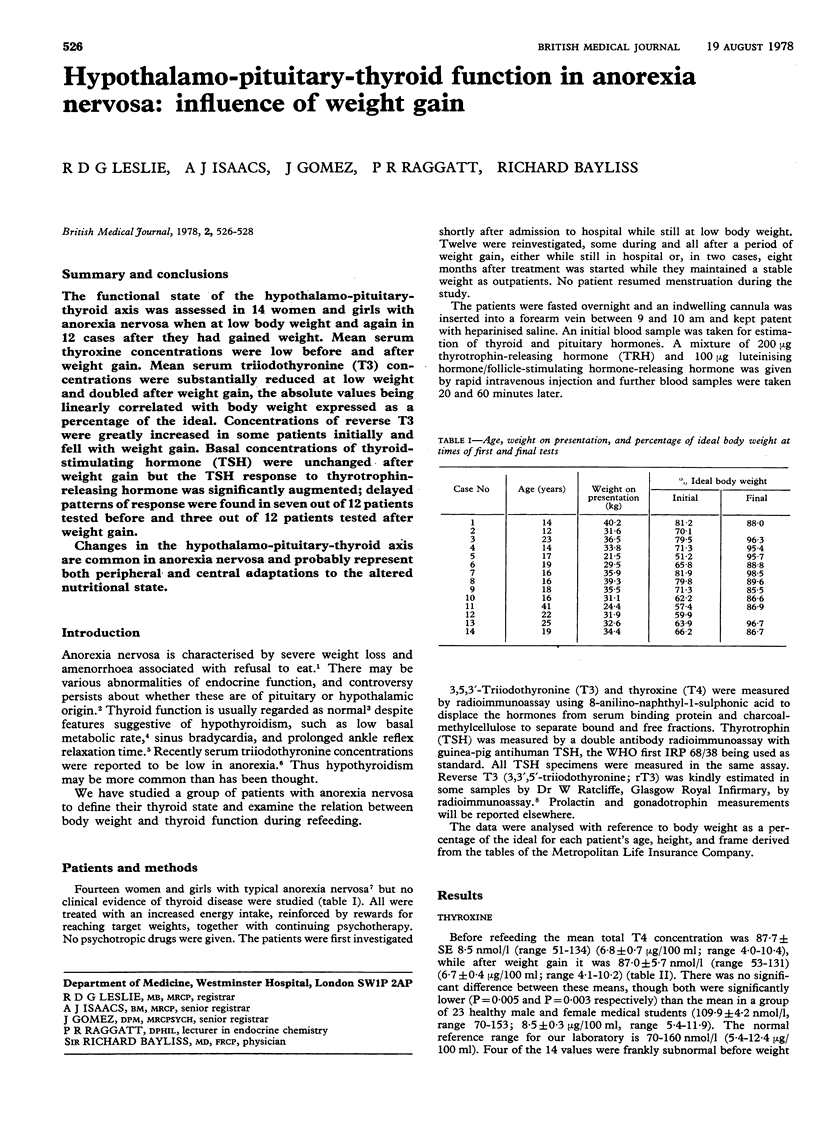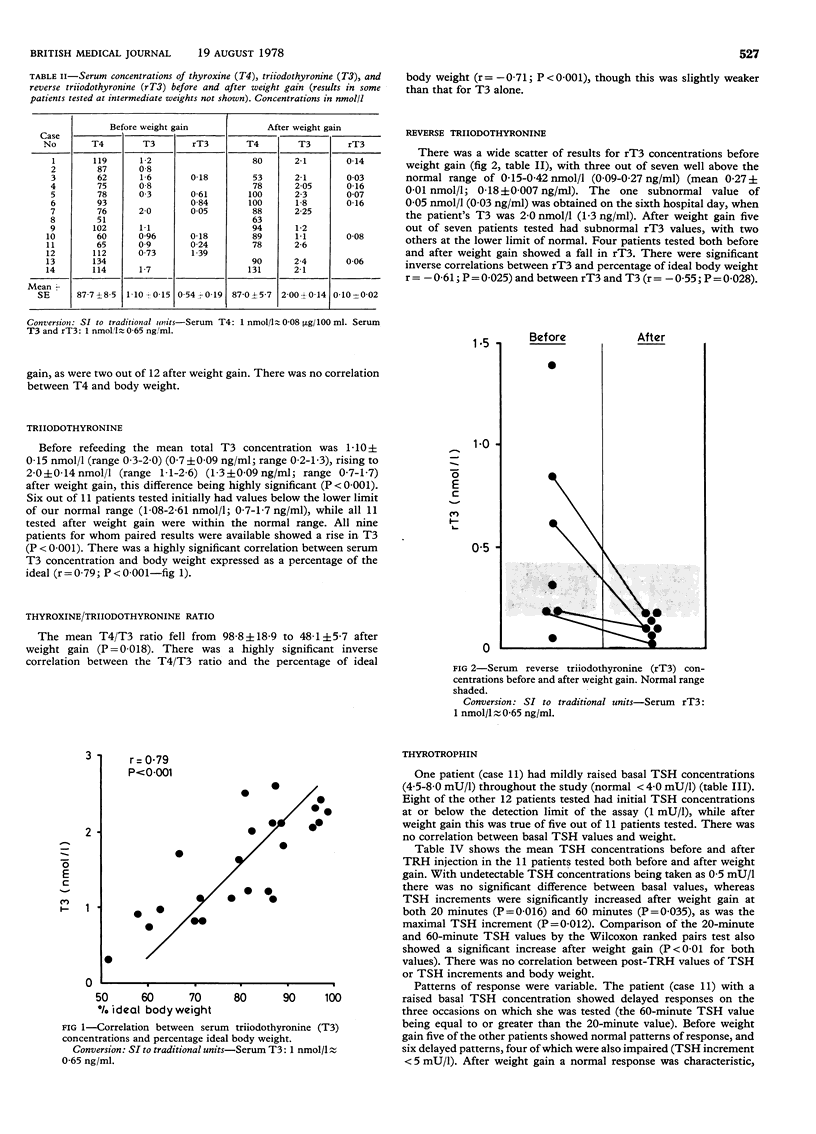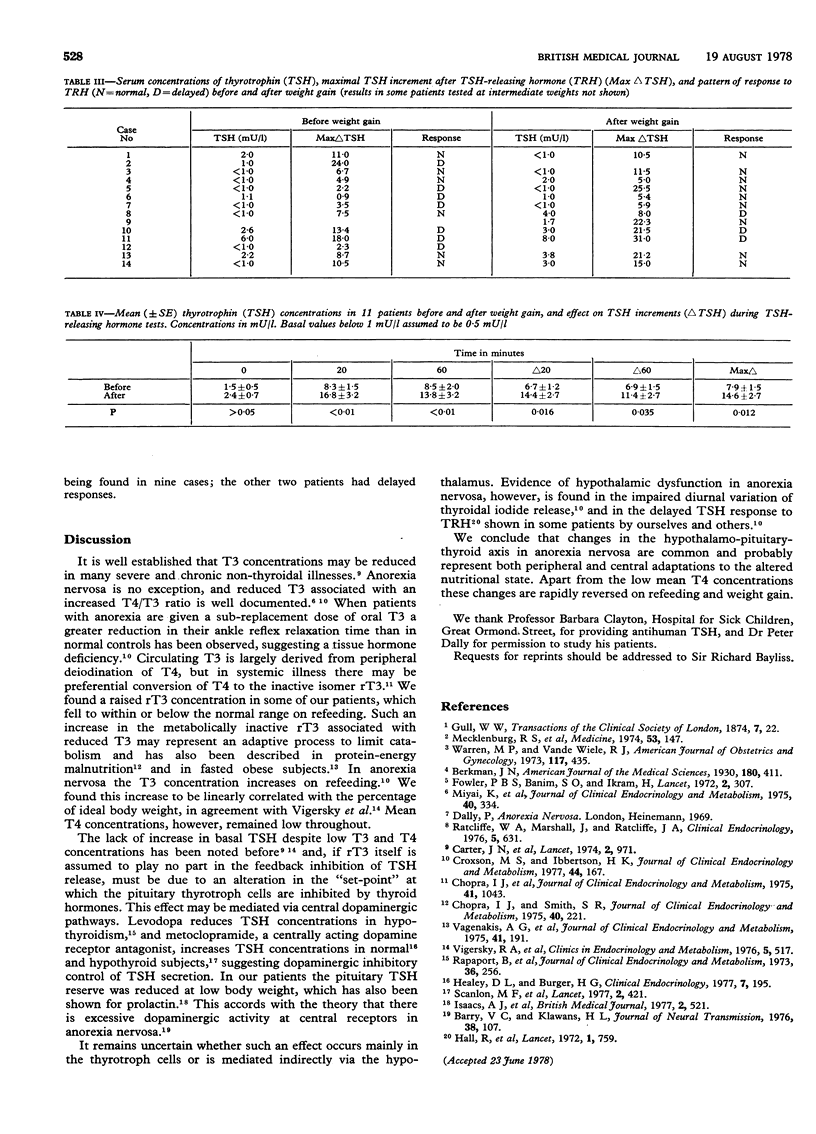Abstract
The functional state of the hypothalamo-pituitary-thyroid axis was assessed in 14 women and girls with anorexia nervosa when at low body weight and again in 12 cases after they had gained weight. Mean serum thyroxine concentrations were low before and after weight gain. Mean serum triiodothyronine (T3) concentrations were substantially reduced at low weight and doubled after weight gain, the absolute values being linearly correlated with body weight expressed as a percentage of the ideal. Concentrations of reverse T3 were greatly increased in some patients initially and fell with weight gain. Basal concentrations of thyroid-stimulating hormone (TSH) were unchanged after weight gain but the TSH response to thyrotrophin-releasing hormone was significantly augmented; delayed patterns of response were found in seven out of 12 patients tested before and three out of 12 patients tested after weight gain. Changes in the hypothalamo-pituitary-thyroid axis are common in anorexia nervosa and probably represent both peripheral and central adaptations to the altered nutritional state.
Full text
PDF


Selected References
These references are in PubMed. This may not be the complete list of references from this article.
- Barry V. C., Klawans H. L. On the role of dopamine in the pathophysiology of anorexia nervosa. J Neural Transm. 1976;38(2):107–122. doi: 10.1007/BF01262969. [DOI] [PubMed] [Google Scholar]
- Carter J. N., Eastman C. J., Corcoran J. M., Lazarus L. Effect of severe, chronic illness on thyroid function. Lancet. 1974 Oct 26;2(7887):971–974. doi: 10.1016/s0140-6736(74)92070-4. [DOI] [PubMed] [Google Scholar]
- Chopra I. J., Chopra U., Smith S. R., Reza M., Solomon D. H. Reciprocal changes in serum concentrations of 3,3',5-triiodothyronine (T3) in systemic illnesses. J Clin Endocrinol Metab. 1975 Dec;41(06):1043–1049. doi: 10.1210/jcem-41-6-1043. [DOI] [PubMed] [Google Scholar]
- Chopra I. J., Smith S. R. Circulating thyroid hormones and thyrotropin in adult patients with protein-calorie malnutrition. J Clin Endocrinol Metab. 1975 Feb;40(2):221–227. doi: 10.1210/jcem-40-2-221. [DOI] [PubMed] [Google Scholar]
- Croxson M. S., Ibbertson H. K. Low serum triiodothyronine (T3) and hypothyroidism in anorexia nervosa. J Clin Endocrinol Metab. 1977 Jan;44(1):167–174. doi: 10.1210/jcem-44-1-167. [DOI] [PubMed] [Google Scholar]
- Fowler P. B., Banim S. O., Ikram H. Prolonged ankle reflex in anorexia nervosa. Lancet. 1972 Aug 12;2(7772):307–308. doi: 10.1016/s0140-6736(72)92909-1. [DOI] [PubMed] [Google Scholar]
- Hall R., Ormston B. J., Besser G. M., Cryer R. J. The thyrotrophin-releasing hormone test in diseases of the pituitary and hypothalamus. Lancet. 1972 Apr 8;1(7754):759–763. doi: 10.1016/s0140-6736(72)90518-1. [DOI] [PubMed] [Google Scholar]
- Healy D. L., Burger H. G. Increased prolactin and thyrotrophin secretion following oral metoclopramide: dose-response relationships. Clin Endocrinol (Oxf) 1977 Sep;7(3):195–201. doi: 10.1111/j.1365-2265.1977.tb01315.x. [DOI] [PubMed] [Google Scholar]
- Isaacs A. J., Leslie D., Gomez J., Raggatt P. R. Prolactin in anorexia nervosa. Br Med J. 1977 Aug 20;2(6085):521–521. doi: 10.1136/bmj.2.6085.521-a. [DOI] [PMC free article] [PubMed] [Google Scholar]
- Mecklenburg R. S., Loriaux D. L., Thompson R. H., Andersen A. E., Lipsett M. B. Hypothalamic dysfunction in patients with anorexia nervosa. Medicine (Baltimore) 1974 Mar;53(2):147–159. doi: 10.1097/00005792-197403000-00003. [DOI] [PubMed] [Google Scholar]
- Miyai K., Yamamoto T., Azukizawa M., Ishibashi K., Kumahara Y. Serum thyroid hormones and thyrotropin in anorexia nervosa. J Clin Endocrinol Metab. 1975 Feb;40(2):334–338. doi: 10.1210/jcem-40-2-334. [DOI] [PubMed] [Google Scholar]
- Rapoport B., Refetoff S., Fang V. S., Friesen H. G. Suppression of serum thyrotropin (TSH) by L-dopa in chronic hypothyroidism: interrelationships in the regulation of TSH and prolactin secretion. J Clin Endocrinol Metab. 1973 Feb;36(2):256–262. doi: 10.1210/jcem-36-2-256. [DOI] [PubMed] [Google Scholar]
- Ratcliffe W. A., Marshall J., Ratcliffe J. G. The radioimmunoassay of 3,3',5' - triiodothyronine (reverse T3) in unextracted human serum. Clin Endocrinol (Oxf) 1976 Nov;5(6):631–641. doi: 10.1111/j.1365-2265.1976.tb03866.x. [DOI] [PubMed] [Google Scholar]
- Scanlon M. F., Weightman D. R., Mora B., Heath M., Shale D. J., Snow M. H., Hall R. Evidence for dopaminergic control of thyrotrophin secretion in man. Lancet. 1977 Aug 27;2(8035):421–423. doi: 10.1016/s0140-6736(77)90607-9. [DOI] [PubMed] [Google Scholar]
- Vagenakis A. G., Burger A., Portnary G. I., Rudolph M., O'Brian J. R., Azizi F., Arky R. A., Nicod P., Ingbar S. H., Braverman L. E. Diversion of peripheral thyroxine metabolism from activating to inactivating pathways during complete fasting. J Clin Endocrinol Metab. 1975 Jul;41(1):191–194. doi: 10.1210/jcem-41-1-191. [DOI] [PubMed] [Google Scholar]
- Vigersky R. A., Loriaux D. L., Andersen A. E., Lipsett M. B. Anorexia nervosa: behavioural and hypothalamic aspects. Clin Endocrinol Metab. 1976 Jul;5(2):517–535. doi: 10.1016/s0300-595x(76)80034-5. [DOI] [PubMed] [Google Scholar]
- Warren M. P., Vande Wiele R. L. Clinical and metabolic features of anorexia nervosa. Am J Obstet Gynecol. 1973 Oct 1;117(3):435–449. doi: 10.1016/0002-9378(73)90053-7. [DOI] [PubMed] [Google Scholar]


